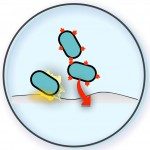Link to Pubmed [PMID] – 11473319
Nature. 2001 Jul 26;412(6845):442-5.
Horizontal gene transfer is a principal source of evolution leading to change in the ecological character of bacterial species. Bacterial conjugation, which promotes the horizontal transfer of genetic material between donor and recipient cells by physical contact, is a phenomenon of fundamental evolutionary consequence. Although conjugation has been studied primarily in liquid, most natural bacterial populations are found associated with environmental surfaces in complex multispecies communities called biofilms. Biofilms are ideally suited to the exchange of genetic material of various origins, and it has been shown that bacterial conjugation occurs within biofilms. Here I investigate the direct contribution of conjugative plasmids themselves to the capacity of the bacterial host to form a biofilm. Natural conjugative plasmids expressed factors that induced planktonic bacteria to form or enter biofilm communities, which favour the infectious transfer of the plasmid. This general connection between conjugation and biofilms suggests that medically relevant plasmid-bearing strains are more likely to form a biofilm. This may influence both the chances of biofilm-related infection risks and of conjugational spread of virulence factors.


